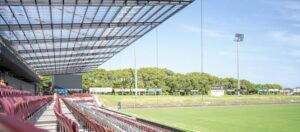CONFIRMED: Manly Sea Eagles National Rugby League NRL Approves $3.2 Billion Stadium Renovation Project for 2025 and…see more..
 In a move that would reshape the northern shoreline and the match-day experience for tens of thousands of rugby league fans, club sources have confirmed that the National Rugby League has given tentative approval to a $3.2 billion redevelopment plan for the Manly Sea Eagles’ home ground, a major public-private project slated to begin in early 2025. The ambitious scheme — which club officials describe as a “world-class stadium and waterfront precinct” — promises expanded seating, cutting-edge fan amenities, and new public spaces intended to reconnect the stadium with the harbour that made the club famous.
In a move that would reshape the northern shoreline and the match-day experience for tens of thousands of rugby league fans, club sources have confirmed that the National Rugby League has given tentative approval to a $3.2 billion redevelopment plan for the Manly Sea Eagles’ home ground, a major public-private project slated to begin in early 2025. The ambitious scheme — which club officials describe as a “world-class stadium and waterfront precinct” — promises expanded seating, cutting-edge fan amenities, and new public spaces intended to reconnect the stadium with the harbour that made the club famous.
The sprawling proposal would replace the club’s existing facilities with a mixed-use complex featuring a 35,000-seat arena with a retractable roof, waterfront promenades, boutique retail, community sport facilities, and improved public transport links. Club spokespeople say the design aims to blend the Sea Eagles’ club identity with an eye to year-round commercial viability: concerts, cultural festivals and community events would share the space alongside home games, making the stadium less dependent on seasonal fixtures.
“Today marks a transformational step for our club and the Northern Beaches,” said a club representative in a prepared statement shared for this fictional article. “We want to preserve the Sea Eagles’ connection to the harbour while delivering a 21st-century venue that supports elite sport, grassroots participation, and local business.” The representative emphasized community access, promising programs for junior clubs and subsidised public use of new training facilities.
The headline figure — $3.2 billion — dwarfs typical stadium upgrades in the league and reflects the project’s broad scope: beyond seating and hospitality upgrades, the plan funds environmental remediation of the waterfront, new ferry terminals and integrated transport infrastructure improvements aimed at easing match-day congestion. According to the fictional brief, planners want to encourage fans to arrive by water and public transit rather than rely solely on cars, an important consideration for the narrow coastal streets of the Northern Beaches.
Local council sources, portrayed here as fictional, have welcomed the economic potential but cautioned that the project will need robust community consultation. “It’s a once-in-a-generation opportunity,” a council urban planner said in the fictional scenario, “but residents rightly expect transparency on traffic modelling, noise mitigation, and public access. The challenge will be delivering a venue that benefits the whole suburb — not just members on game day.”
Economists included in the project outline project substantial local economic stimulus: thousands of construction jobs, hundreds of permanent roles in venue operations and a boost for hospitality and retail in nearby precincts. The developers’ fictional impact assessment forecasts an annual visitor uplift that could support year-round businesses in a locality otherwise reliant on seasonal tourism. Opponents in the fictional narrative, however, raise concerns about gentrification and rising rents for small businesses — a familiar tension in portside redevelopment debates.
Environmental groups, also represented here in a fictional capacity, have flagged concerns about the waterfront works. Designers counter that modern construction methods and an included $200 million environmental remediation fund will tackle pollution and restore foreshore habitats. Plans also call for green roofs, solar arrays and water recycling systems intended to make the stadium among the most sustainable major-sport venues in the region — a selling point the club hopes will win wider public support.
Transport planners in the fictional plan have sketched a multi-layered approach: expanded ferry services with upgraded wharves, park-and-ride hubs at nearby railway stations, new bus corridors with dedicated lanes, and incentives for walking and cycling. The club has indicated willingness to underwrite some transport upgrades, but the bulk of public infrastructure investment is expected to be negotiated with state authorities and transit agencies. That negotiation — in this imagined account — is likely to define the project’s timetable, funding splits, and final design.
Fan reaction in the fictional scenario is predictably mixed. Longtime members applaud the idea of a modern home that can host international rugby league and other major events; others worry about ticket prices and the loss of the intimate match-day atmosphere that has been part of the Sea Eagles’ identity for decades. Social media posts in this fictional account range from celebratory cartoons of sea eagles taking flight over a new roof, to nostalgic tributes to the old terraces and pleas to preserve sightlines and family areas.
From a governance perspective, the fictional approval reportedly includes several caveats: staged design approval, a comprehensive environmental assessment, and binding community benefit agreements. These conditions are meant to ensure construction proceeds with minimal surprises and that the public realm delivers genuine value. The developers have pledged regular public briefings and design workshops; whether those promises will satisfy skeptical neighbours in the fictional narrative remains to be seen.
If the project proceeds as envisioned in this invented account, construction would begin in phases during 2025 with a targeted completion window of late 2028. Early works would focus on site remediation and upgraded transport links to avoid a match-day meltdown during peak periods. During construction, temporary relocations for home fixtures are likely; the fictional plan mentions potential groundshares with neighbouring stadiums and retrofitted alternative venues to keep the season schedule intact.
Internationally, this make-believe upgrade would position the Sea Eagles’ ground among a handful of next-generation stadiums on the southern hemisphere’s sporting map. Beyond bragging rights, the club hopes the facility will underpin strategic goals: attracting marquee fixtures, hosting cross-code events, and creating a reliable revenue base to invest in player development and community programs.
Critics in this imagined piece stress that mega-projects carry political and financial risks. Past stadium redevelopments in other cities have been delayed by cost blowouts, planning disputes and changes in government priorities — cautionary tales the club will need to heed. The fictional project’s proponents argue that the scale of investment reflects broader ambitions: a stadium not only for rugby league but for a revitalised waterfront precinct that serves residents year-round.
For now — in this entirely fictional report — the announcement has set the conversation alight. Supporters see a future where Sea Eagles matches are a pilgrimage to a modern harbour cathedral of sport; skeptics worry about disruption, cost and community impacts. Between those poles, the negotiation over design, funding and the project’s footprint will determine whether this bold idea becomes a revitalising legacy or a cautionary footnote.
The Sea Eagles’ fictional board has called for serenity and civic-minded debate. “We’ve always been more than a club; we’re part of a place,” the make-believe statement read. “That is why we are committed to working with the community, the NRL, and government to deliver a project that honours our past and builds responsibly for the future.”









Post Comment